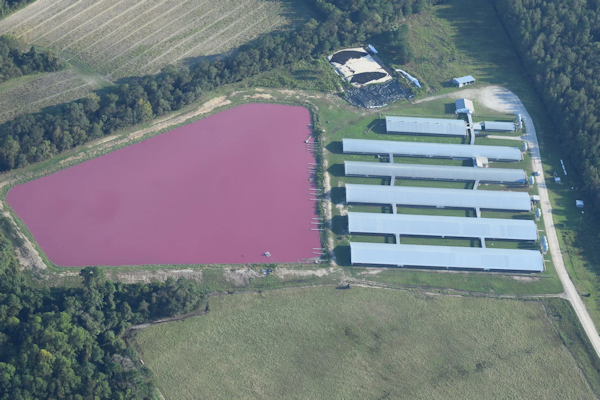SEJournal Online is the digital news magazine of the Society of Environmental Journalists. Learn more about SEJournal Online, including submission, subscription and advertising information.
 |
| An industrial hog farm and waste lagoon in Sampson County, North Carolina. Facilities like this are disproportionately located in the state’s most vulnerable communities. Photo: Courtesy of Waterkeeper Alliance. |
EJ Academy: From Swine Waste, Student Journalist Extracts Prize-Winning Story
By Cameron Oglesby
North Carolina is the second-largest hog-producing state in the country — a distinction that is linked to some prime examples of environmental racism. The state’s industrial hog farms are disproportionately located in Black and Indigenous communities and near other industries producing air and water pollution.
The hog waste ends up in lagoons that leave the feces, urine and other fluids open to the elements. This often results in unsavory odors, methane and ammonia emissions and water pollution when these lagoons flood or breach.
The waste from these pits is also often sprayed on neighboring fields, the vapor making its way into the lungs of those living nearby.
I first learned about the hog farm issue as a freshman at Duke University in 2018. At the time, whispers of environmental racism in state swine agriculture were often masked by louder pushes for swine biogas investment for campus carbon neutrality.
Media coverage was limited and focused primarily on
the swine industry’s historical harm, rather than the increased
hazards of biogas as an up-and-coming energy source.
Media coverage of the biogas issue was limited and focused primarily on the swine industry’s historical harm, rather than the increased hazards of biogas as an up-and-coming energy source. Usually it was only emphasized as a new industry that would allow the hog industry to make money off of an outdated waste management system in North Carolina’s most vulnerable communities.
I believed there was a need to dive into swine biogas as its own issue and to highlight the racism at its core. So when I joined Grist as an editorial intern in my senior year, I pitched a piece about it.
I didn’t expect the reporting and writing would be so complicated or that this story, “Hogwash,” would become my first feature-length article as an environmental journalist.
Prioritizing community
I started my reporting in conversations with the community, because I wanted community impacts and perspective to serve as the story centerpiece.
Beyond that, it required a bit of digging to really parse out why biogas, not just the swine industry, was the bad guy here. Many residents could only speak to the impact of sprayed pig waste on their quality of life.
As someone who was not previously familiar with investigative reporting, I was also making my first foray into scrutinizing public documents.
When I brought my first draft of the article to my editor, they asked for more interviews, more perspectives. They said we needed to hear from the energy providers, from government, from the corporate giants leading the biogas charge.
Tackling tightlipped sources
 |
| Cameron Oglesby |
The corporate piece was the most difficult element for me. Not only were these sources difficult to get a hold of, but their answers often directly contradicted both resident and government claims.
At one point, the spokesperson for the Smithfield Foods biogas project said that swine waste could not be a toxic substance because everything had gone through the digestive tract of a pig. In other words, pig poop is harmless, whether inhaled or even ingested, because it is organic.
Industry representatives provided one written statement and wouldn’t elaborate in either a phone or Zoom conversation on the contradictions to community testimony. We had to just take what they said in the statement at face value or leave it out of the article entirely.
In the end, I overcame this challenge by contrasting the industry statements with comments provided by issue experts, government documents and community members.
In the article, when the swine industry said that the biogas venture would be a boon to the community, I countered with a plethora of statements and statistics contradicting those claims. When Smithfield said that the spraying of hog waste on fields is regulated, I countered with previous promises the industry made to move to “environmentally superior technology” and systems.
One portion of the article featured an almost cartoonish back and forth between the North Carolina Department of Environmental Quality and Align RNG, the joint venture between Smithfield Foods and Dominion Energy that was building the biogas facilities, regarding their air quality permits. The DEQ would ask Smithfield for more information on their biogas farm locations; Smithfield would say no. The DEQ would demand; Smithfield would say no. All these letters were publicly available as a part of the DEQ’s permitting process.
Lessons learned
The experience of shedding light on an underreported issue and parsing out the various points of corruption and complexity was an adventure. I also learned many lessons along the way.
Working on this article taught me how to effectively bring more creative long-form writing into a journalistic piece, a skill that I’ve since used to develop numerous feature-length articles.
It also taught me the power of multiple angles and interviews. I didn’t just interview two or three experts for this piece, but five or six individuals representing all sides of the issue.
I also learned just how aligned different stakeholders often are on environmental justice issues — and that a good article would not and could not reduce these complex issues to a “he said, she said” argument. It is that nuance that I now attempt to bring into my work.
Writing this article showed me the value of a collaborative
editorial process — an early edit, a check-in call, a follow-up
conversation, a second and third edit from other journalists.
Perhaps most significantly, writing this article showed me the value of a collaborative editorial process — an early edit, a check-in call, a follow-up conversation, a second and third edit from other journalists.
Being able to draw from the technical and literary expertise of a roomful of journalists helped strengthen the focus of the piece. Since then, I’ve attempted to replicate that back-and-forth — the mix of conversations, deep edits and top edits — in all my newsroom interactions.
Outside of the newsroom, I have had the pleasure of seeing my article get educational traction. Several faculty members at Duke have let me know they’ve included my article as mandatory reading in their syllabi. A faculty member at Appalachian State University also told me she had included it in her syllabus.
My first environmental journalism feature has become more of an educational tool than I ever thought possible, both for readers and for me.
Cameron Oglesby is a youth environmental justice organizer, oral historian, ecologist and student journalist working as an environmental justice reporter for Yale Climate Connections and Associate Editor for Earth in Color with bylines in The Nation, The Margin, Grist, Environmental Health News and Southerly and Scalawag Magazines.
* From the weekly news magazine SEJournal Online, Vol. 8, No. 10. Content from each new issue of SEJournal Online is available to the public via the SEJournal Online main page. Subscribe to the e-newsletter here. And see past issues of the SEJournal archived here.













 Advertisement
Advertisement 



